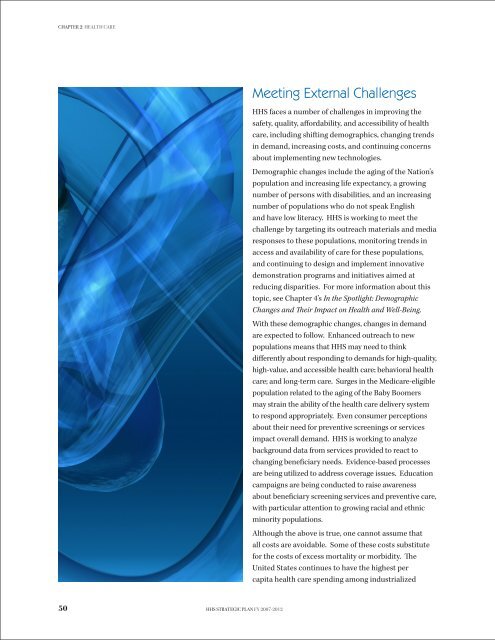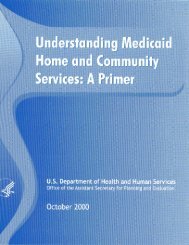CHAPTER 2: <strong>Health</strong> careMeeting External ChallengesHHS faces a number <strong>of</strong> challenges in improving thesafety, quality, affordability, <strong>and</strong> accessibility <strong>of</strong> healthcare, including shifting demographics, changing trendsin dem<strong>and</strong>, increasing costs, <strong>and</strong> continuing concernsabout implementing new technologies.Demographic changes include the aging <strong>of</strong> the Nation’spopulation <strong>and</strong> increasing life expectancy, a growingnumber <strong>of</strong> persons with disabilities, <strong>and</strong> an increasingnumber <strong>of</strong> populations who do not speak English<strong>and</strong> have low literacy. HHS is working to meet thechallenge by targeting its outreach materials <strong>and</strong> mediaresponses to these populations, monitoring trends inaccess <strong>and</strong> availability <strong>of</strong> care for these populations,<strong>and</strong> continuing to design <strong>and</strong> implement innovativedemonstration programs <strong>and</strong> initiatives aimed atreducing disparities. For more information about thistopic, see Chapter 4’s In the Spotlight: DemographicChanges <strong>and</strong> Their Impact on <strong>Health</strong> <strong>and</strong> Well-Being.With these demographic changes, changes in dem<strong>and</strong>are expected to follow. Enhanced outreach to newpopulations means that HHS may need to thinkdifferently about responding to dem<strong>and</strong>s for high-quality,high-value, <strong>and</strong> accessible health care; behavioral healthcare; <strong>and</strong> long-term care. Surges in the Medicare-eligiblepopulation related to the aging <strong>of</strong> the Baby Boomersmay strain the ability <strong>of</strong> the health care delivery systemto respond appropriately. Even consumer perceptionsabout their need for preventive screenings or servicesimpact overall dem<strong>and</strong>. HHS is working to analyzebackground data from services provided to react tochanging beneficiary needs. Evidence-based processesare being utilized to address coverage issues. Educationcampaigns are being conducted to raise awarenessabout beneficiary screening services <strong>and</strong> preventive care,with particular attention to growing racial <strong>and</strong> ethnicminority populations.Although the above is true, one cannot assume thatall costs are avoidable. Some <strong>of</strong> these costs substitutefor the costs <strong>of</strong> excess mortality or morbidity. TheUnited States continues to have the highest percapita health care spending among industrialized50 HHS Strategic Plan FY 2007-2012
CHAPTER 2: <strong>Health</strong> carecountries. The health care cost per capita for personsaged 65 years or older in the United States is three t<strong>of</strong>ive times greater than the cost for persons youngerthan 65, <strong>and</strong> the rapid growth in the number <strong>of</strong> olderpersons, coupled with continued advances in medicaltechnology, is expected to create upward pressure onhealth care <strong>and</strong> long-term care spending. Medicalinflation also contributes to the rising cost <strong>of</strong> providingappropriate quality health services, widening the gapbetween increased need <strong>and</strong> available resources. Aneconomic downturn could increase dem<strong>and</strong> for healthcare <strong>and</strong> long-term care services from safety netproviders <strong>and</strong> strain the ability <strong>of</strong> current providersto meet the dem<strong>and</strong>. In response to these concerns,HHS will continue to monitor trends in access to careamong uninsured, underinsured, <strong>and</strong> low-incomeindividuals, <strong>and</strong> to design <strong>and</strong> implement innovativedemonstration programs that seek to improve health<strong>and</strong> access to care among these groups. HHS willidentify new resources to meet increased dem<strong>and</strong>s,focusing on efficiency <strong>and</strong> effectiveness <strong>of</strong> health careservice delivery. HHS will also continue to cultivate astrong focus on prevention <strong>and</strong> wellness services (seeStrategic Goal 2, Objective 2.3, for more detail).Improving health care <strong>and</strong> the health <strong>of</strong> the populationthrough the adoption <strong>of</strong> health information technology(health IT) is clearly a priority for HHS (see In the Spotlight:Advancing the Development <strong>and</strong> Use <strong>of</strong> <strong>Health</strong> InformationTechnology). The nationwide implementation <strong>of</strong> aninteroperable health IT infrastructure has the potential tolower costs, reduce medical errors, improve the quality <strong>of</strong>care, <strong>and</strong> provide patients <strong>and</strong> physicians with new waysto interact. However, nationwide health IT adoption canbe accomplished only through a coordinated effort <strong>of</strong>many stakeholders, from State <strong>and</strong> Federal governments<strong>and</strong> the private sector. HHS has taken great care to engagerepresentatives from all <strong>of</strong> these sectors in all <strong>of</strong> our healthIT initiatives—an effort that involves many processes <strong>and</strong>the work <strong>of</strong> many hundreds <strong>of</strong> participants. In September2005, HHS formed a Federal Advisory Committee(subject to the Federal Advisory Committee Act 4 <strong>of</strong> 1972(Public Law 92-463), as amended), the American <strong>Health</strong>Information Community (AHIC), to advise the Secretaryon how to accelerate the development <strong>and</strong> adoption <strong>of</strong>health IT <strong>and</strong> help advance efforts needed to achieve thePresident’s goal for most Americans to have access tosecure electronic health records by 2014. Additionally, theAHIC provides input <strong>and</strong> recommendations to HHS onhow to make health records digital <strong>and</strong> interoperable <strong>and</strong>how to protect the privacy <strong>and</strong> security <strong>of</strong> those records, ina smooth, market-led way.4 In 1972, the Federal Advisory Committee Act (Public Law 92-463) was enacted by the U.S. Congress. Its purpose was to ensurethat advice rendered to the executive branch by the various advisorycommittees, task forces, boards, <strong>and</strong> commissions formed overthe years by the Congress <strong>and</strong> the President be both objective <strong>and</strong>accessible to the public. The act formalized a process for establishing,operating, overseeing, <strong>and</strong> terminating these advisory bodies.HHS Strategic Plan FY 2007-201251
















